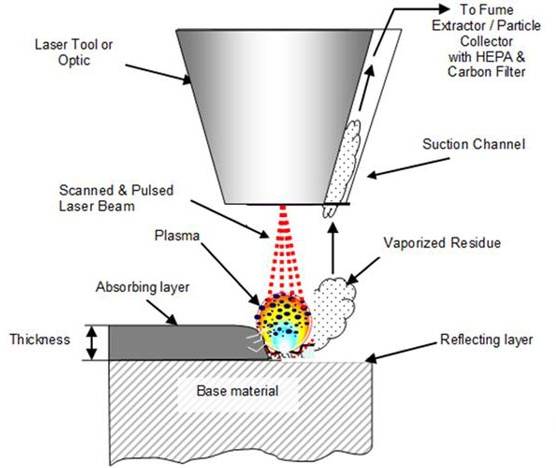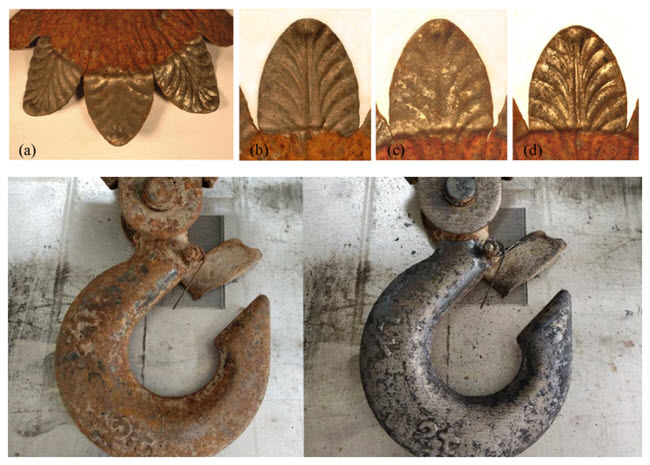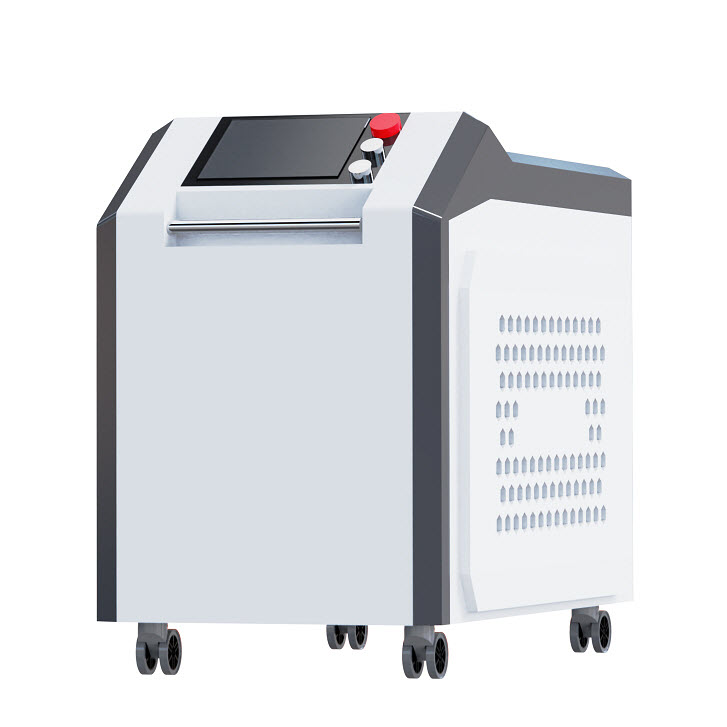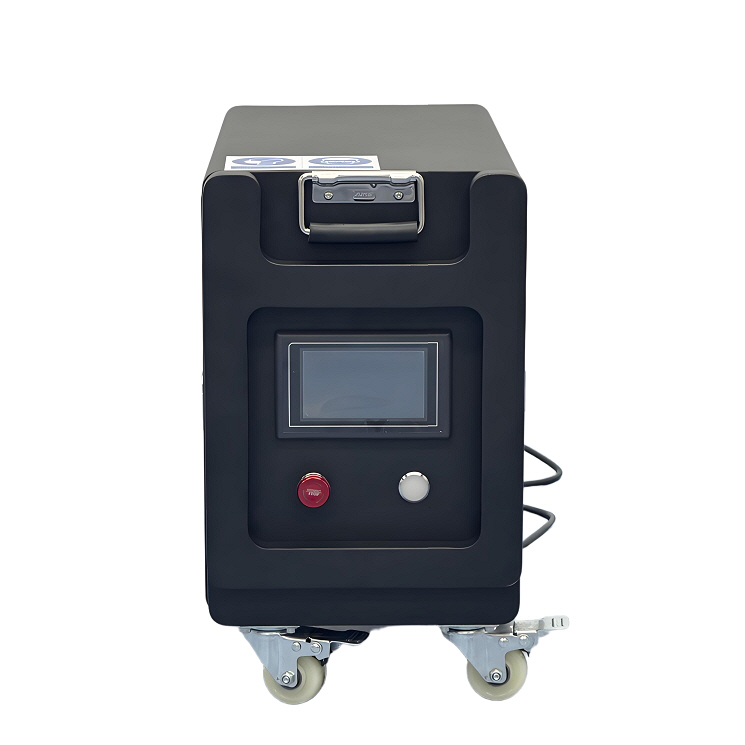
Laser Surface Cleaning Technology - Black Technology for Surface Purification
2025-05-18When it refers to laser, we are all familiar with it. It is another important invention after nuclear energy, semiconductors and computers in the 20th century. Due to its special characteristics such as high brightness, monochromaticity, directionality and coherence, laser has been widely used in various fields, and is well-known as the most accurate ruler, the brightest light and the fastest life. After more than half a century of development, laser technology has been combined with multiple disciplines to form new technical application fields, such as optoelectronic technology, laser medical treatment and photon biology, laser processing technology, laser detection and measurement technology, etc. The emergence of these cross-technologies and new disciplines has greatly promoted the development of related industries. Laser surface cleaning technology is one of the most common application. In this post, we will share the development, working principle, advantages and etc. of laser surface cleaning technology with you guys. Continue reading to get more information.
I. The Birth and Development History of Laser Cleaning Technology
The birth of laser cleaning technology can be traced back to the 1960s. In 1965, Nobel Prize winner Schawlow used pulsed laser to irradiate ink-printed paper, and the ink fonts on the paper surface quickly vaporized without damaging the paper surface itself. He first proposed the "laser eraser", as shown in the figure. In 1969, Bedair et al. used Q-switched laser to remove oxygen and sulfur pollution on the surface of nickel, and proposed the concept of laser cleaning. In 1973, Asmus' team first reported laser cultural relic cleaning. They laser cleaned a variety of cultural relics, including Leonardo da Vinci statues and murals. In 1974, Fox used Q-switched neodymium glass laser to effectively remove paint layers on resin and metal substrates. In the 1980s, when the new technology of electron beam projection etching was used to prepare the mask, the mask surface would inevitably be stained with particulate contaminants, resulting in defective products, but traditional ultrasonic cleaning, mechanical cleaning, chemical cleaning and other technologies could not remove particulate contaminants. In 1982, Zapka et al. used focused laser to irradiate the mask and successfully cleaned the attached contaminants without damaging the mask pattern. It can be seen that the invention of laser cleaning technology is mainly to clean tiny particles on the surface of semiconductors. Its development and the progress of semiconductor technology promote each other. At the same time, the technology is also constantly exploring applications in other fields.
II. The Working Principle of Laser Surface Cleaning Technology
The laser can be used for cleaning and it does not cause damage to the object being cleaned. Hereof, we will talk about the working principle of the laser surface cleaning technology.
Laser cleaning is the process of removing material from a solid (or sometimes liquid) surface by irradiation with a laser beam. At low laser flux, the material is heated by the absorbed laser energy and evaporates or sublimates. At high laser flux, the material is usually converted into a plasma. Usually, laser cleaning refers to the removal of material with a pulsed laser, but if the laser intensity is high enough, the material can be ablated with a continuous wave laser beam. Excimer lasers in the deep ultraviolet are mainly used for photoablation. The laser wavelength used for photoablation is about 200nm. The depth of absorption of laser energy and the amount of material removed by a single laser pulse depend on the optical properties of the material as well as the laser wavelength and pulse length. The total mass ablated from the target per laser pulse is usually called the ablation rate. Laser radiation characteristics such as laser beam scanning speed and scan line coverage can significantly affect the ablation process.

III. Working Types of Laser Surface Cleaning Technology
According to the relationship between the laser and the surface of the object to be cleaned, the working types of laser cleaning technology can be divided into direct contact and indirect contact.
Direct Contact Laser Cleaning
According to different action mechanisms, direct contact can be divided into three types:
1. Pulse laser directly irradiates the surface of the object, and uses the high energy characteristics of the laser to achieve decontamination. The temperature of the substrate and the contaminant increases due to the absorption of laser energy. The absorption rate of the laser by the surface contaminant is significantly higher than that of the substrate. In the central area of the laser action, the contaminant is removed due to vaporization, ablation, photochemistry, thermal decomposition, etc. In the edge area of the laser action, the contaminant is removed due to thermal stress, thermal shock and physical fracture.
2. A layer of liquid film is pre-covered on the surface of the object to be cleaned, and the laser is directly irradiated. The liquid film absorbs the laser energy and heats up rapidly, generating a strong impact force to remove the contaminant on the substrate surface.
3. Short pulse laser irradiates the substrate surface. Due to the different thermal expansion coefficients of different materials, under the irradiation of short pulse laser, the surface contaminant and the substrate will undergo high-frequency thermal expansion and contraction of different degrees, generating an oscillation effect, causing the contaminant to fall off the substrate surface.
Indirect Contact Laser Cleaning
Indirect contact laser cleaning does not directly contact the surface to be cleaned. The laser is emitted in a direction parallel to the surface. After being focused by a lens, the high energy causes the gas to be broken down, forming a laser plasma. The plasma contacts the pollutants during the rapid expansion process, and the impact force generated causes the pollutants to detach from the surface. This method cleans submicron or nanometer particles and has very strict process requirements. It must ensure that the air can be ionized and that the laser is kept at a suitable distance from the substrate surface to ensure that the impact force acting on the particles is large enough.
IV. Why Laser Cleaning Does Not Cause Damage to the Surface Being Cleaned?
The plasma is only generated when the energy density is above a threshold value, which depends on the contamination layer or oxide layer to be removed. This threshold effect is very important for effective cleaning while ensuring the safety of the substrate material. There is also a second threshold for the occurrence of plasma. If the energy density exceeds this threshold, the substrate material will be destroyed. For effective cleaning while ensuring the safety of the substrate material, the laser parameters must be adjusted according to the situation so that the energy density of the light pulse is strictly between the two thresholds.
Each laser pulse removes a certain thickness of the contamination layer. If the contamination layer is thick, multiple pulses are required for cleaning. The number of pulses required to clean the surface depends on the degree of surface contamination. An important consequence of the two thresholds is the self-control of the cleaning. Light pulses with energy density above the first threshold will continue to remove contaminants until they reach the substrate material. Because their energy density is below the destruction threshold of the substrate material, the substrate is not damaged.
V. Comparison of Laser Surface Cleaning Technology and Traditional Cleaning Methods Like Sandblasting
Sandblast cleaning is a common surface treatment technology that uses high-speed jet abrasives (such as sand, glass beads, steel balls, etc.) to impact the surface of the treated object, thereby removing stains, oxide layers, paint, rust and other surface defects, while also improving surface quality and enhancing adhesion.
Both laser cleaning and sandblasting cleaning are widely used. But they have many differences in the effect after cleaning, substrate effect, cleaning accuracy, environmental protection, budget, and other aspects. Hereof, let's take a look at what exactly they are different in these points.
| Items | Laser Surface Cleaning | Sandblasting Cleaning |
| Technique | Photothermal effect/shock wave stripping of contaminants | Abrasive particles are usually propelled at high speeds to remove contaminants. |
| Cleaning Accuracy | Laser cleaning is highly precise:micron level (can clean 0.1mm gap) | Millimeter level (limited by abrasive particle size) |
| Substrate Effect | Always gentle on various substrates and ensures less damage. | It may affect or damage delicate or soft materials. |
| Security | Wear protective glasses and operate correctly, there is no risk. | Sandblasting involves the forceful ejection of abrasive particles. This method can result in serious injury if the operator does not use safety gear correctly. |
| Environmental Protection | It produces almost no dust or any waste particles. It is environmentally friendly. | When it hits the pollutants with great force, dust is generated. This dust may affect the surrounding air quality and cause health risks. |
| Cost | The initial purchase cost of a laser cleaning machine is high, but the subsequent ongoing maintenance costs are low. | The initial purchase cost of a sandblasting machine is low, but the subsequent operating costs are high, and the abrasive particles need to be cleaned and replaced regularly. |
VI. Applications of Laser Surface Cleaning Technology
At present, laser cleaning technology is used in many manufacturing fields such as microelectronics, rail transit, aviation, shipbuilding, automobiles, etc. Typical applications mainly include removal of particulate pollutants, rust, paint, oil, oxide film, etc., and it shows a diversified development trend. It has also been effectively tried and successfully applied in the field of cultural relics cleaning and protection.

1. Laser rust removal
Metal objects are prone to rust when exposed to humid air for a long time. The presence of rust not only affects the performance and accelerates corrosion, but also has a serious impact on the safety and life of the object. Traditional rust removal methods include shot peening and chemical cleaning. These two methods are highly efficient and mature in technology, but they will pollute the environment and are harmful to the health of the operator. Therefore, laser surface cleaning technology has received widespread attention. It is green and environmentally friendly, highly efficient, highly precise, and low-cost. It can replace conventional cleaning methods and has been gradually applied in industry.
2. Laser paint stripping
Large equipment such as ships, aircraft, and bridges need to be repainted regularly. Before repainting, the aged and damaged paint needs to be removed first. This process is called paint stripping. In the process of paint stripping, the aged paint must be removed cleanly without damaging the substrate. However, traditional paint stripping methods generally have disadvantages such as low efficiency, high energy consumption, insufficient accuracy of paint layer removal thickness, and poor surface uniformity, and cannot meet the requirements for controllable removal of the paint layer. Compared with traditional paint removal technology, laser cleaning technology is green, safe and environmentally friendly, with little damage to the substrate, high efficiency, and accurate laser positioning. It is suitable for complex-shaped structural parts such as aircraft and ships.
3. Laser cleaning of electronic components
Tiny contaminants on electronic components will reduce electronic efficiency and cause damage to electronic circuit boards. With the development of science and technology, semiconductors and microelectronic devices are getting smaller and smaller, and the particles that need to be cleaned are also getting smaller and smaller, making cleaning more difficult. Traditional water washing and ultrasonic cleaning cannot achieve such high-precision cleaning effects, so laser cleaning brings new hope and becomes the best cleaning method. Lasers are widely used in cleaning electronic components, such as electronic circuit boards, silicon wafers, integrated circuits, flexible circuits, optoelectronic devices, etc. With the development of science and technology, the integration of these devices has increased, the number of pins has increased, and the holes have become smaller and smaller. Traditional cleaning methods are difficult to work. Laser cleaning can effectively remove dust, grease, oxides and other particles on the surface of electronic components due to its high precision, easy automation, adjustable parameters, and high cleaning efficiency, effectively improving the durability of electronic components. Polyimide film is an important material in electronic components. It is the dielectric material of the internal link structure of the multi-layer packaging film of high-speed and high-density electronic components. However, it is often covered with some particulate pollutants, including titanium particles, chromium particles, tungsten particles, nickel particles, etc. These pollutants need to be cleaned to ensure the normal operation of the polyimide film.

4. Laser cleaning of cultural relics
The surface of cultural relics is often covered with soil pollutants, corrosion products, dust, organic stains and crusts. These pollutants will change the chemical properties of cultural relics and affect their appearance. Therefore, the contaminated cultural relics need to be cleaned. Due to the preciousness and non-renewable nature of cultural relics, the requirements for cleaning technology are very high. Traditional cultural relics cleaning methods mainly include chemical methods and mechanical methods, both of which will cause a certain degree of damage to the cultural relics. Therefore, cultural relics laser cleaning technology has unique advantages such as object selectivity, environmental friendliness, non-contact, and strong controllability, and has gradually become one of the important means of cleaning, restoration and protection of cultural relics.

5. Other aspects
In the past, in the medical field, people often used chemical agents to clean patients' tattoos. However, this method not only cannot completely remove the pigment on the skin, but also damages the health of the skin and may even leave scars or cause inflammation. However, when laser cleaning technology is used to clean patients' tattoos, the laser will only produce a slight burning effect on the skin surface and will not cause serious damage to the patient's skin. The pigment particles inside the skin will be crushed by the energy transmitted by the laser and then completely decomposed through the cell's own metabolic process, as shown in the figure. The scope of laser cleaning is still expanding. It has been used for oil leaks on the sea surface, engine carbon deposits, urban graffiti, teeth, biological warfare agents, poisons, etc.
If you have any question or interest in our laser cleaning machines, please don't be hesitate to drop us a line.


